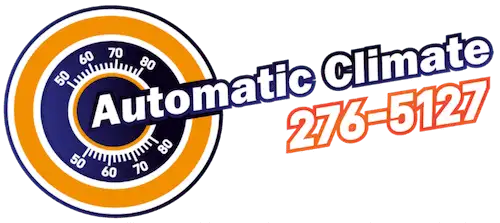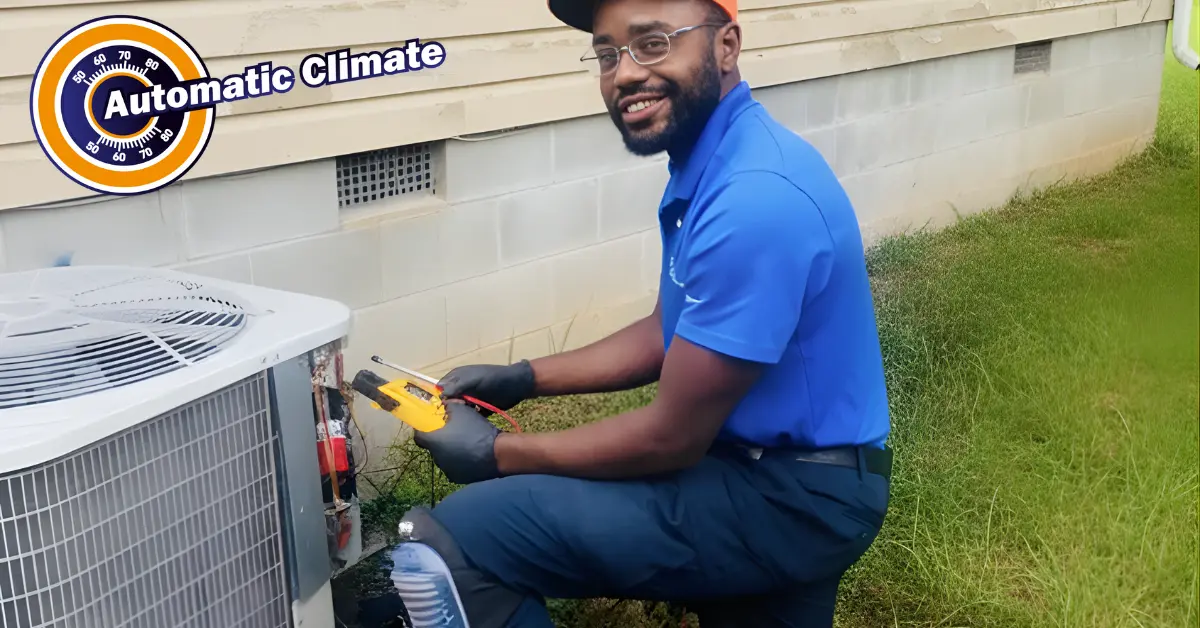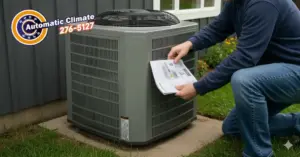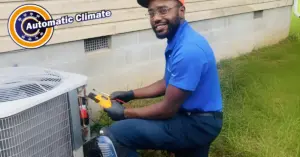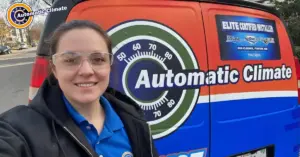Top 7 Reasons Your Furnace Isn’t Kicking On (And Who to Call)
Written by Cole Summers at Automatic Climate in Richmond, Virginia.
That blast of icy air when you’re expecting a cozy wave of heat. The sinking feeling when you hear… nothing. A furnace isn’t kicking on right when you need it most is one of a homeowner’s worst feelings, especially here in Richmond. You walk over to the thermostat, crank it up, and wait. Still nothing. The silence is almost as cold as the air. Before you panic, you should know that a furnace isn’t kicking on for many reasons, and some of them are surprisingly simple fixes you might be able to handle yourself.
But how do you know if it’s a 5-minute DIY fix or a sign of a serious problem needing professional heating repair? We’ve been helping Richmond homeowners with their HVAC systems since 1983, and our team at Automatic Climate has seen it all. We’re going to walk you through the top 7 reasons your furnace isn’t kicking on, from the most common oversights to the more complex mechanical furnace problems. We’ll tell you what to check, how to fix it, and when it’s time to stop troubleshooting and call our professionally trained technicians.
“Winter is not a season, it’s a celebration.” – Anamika Mishra
It’s hard to celebrate when your furnace isn’t kicking on. Let’s get you back to feeling warm and comfortable. Here’s what to do when you find your furnace isn’t kicking on.
Reason #1: Thermostat Troubles (The “Is it plugged in?” Fix)
It sounds basic, but you would be amazed how often the problem isn’t the furnace at all, but the thermostat. It’s the brain of your heating system, and if the brain isn’t sending the right signals, the body won’t work. If your furnace isn’t kicking on, this is the very first place you should look. It’s the most common and easiest fix.
What to Check Yourself (DIY Steps):
- Check the Setting: This is step one. Is the thermostat set to “HEAT”? Someone in the house might have accidentally switched it to “COOL” or “OFF” during a milder day. It happens more than you think.
- Raise the Temperature: Ensure the temperature setting is at least 5 degrees *above* the current room temperature. If you have it set to 68° and the room is already 68° (or the thermostat *thinks* it is), it won’t send the signal to turn on.
- Check the Batteries: If you have a digital thermostat that isn’t hard-wired, it runs on batteries. If the screen is blank or flashing a “low battery” icon, your furnace isn’t kicking on simply because the thermostat is dead. Replace the batteries (usually AA or AAA) and see if it comes to life.
- Look for Error Codes: Modern smart thermostats will often tell you what’s wrong. Look for error codes, “Check System” warnings, or connectivity issues. A simple reset or Wi-Fi reconnect might be all it needs.
- Clean It: This is a less common issue, but older, non-digital thermostats can get dirty. Dust buildup on the internal contacts can prevent it from getting an accurate reading.
When to Call Automatic Climate:
If you’ve replaced the batteries, confirmed it’s on “HEAT,” and set the temperature way up, but your furnace isn’t kicking on still, it’s time to call us. It could be a faulty thermostat, loose wiring, or a miscalibration. These are not things you should try to fix yourself, as it involves electrical connections. Our technicians can quickly diagnose if the problem is the thermostat or something further down the line.
Reason #2: A Dirty or Clogged Air Filter
This is the number one cause of furnace problems we see in Richmond. Your furnace needs to breathe. It sucks in cold air from your home, heats it, and blows it back out. The air filter’s job is to protect the sensitive internal components from dust, dirt, pet hair, and dander. But when that filter gets too clogged, it’s like trying to run a marathon while breathing through a coffee stirrer.
A severely clogged filter restricts airflow. This can cause the heat exchanger—the part that gets very hot—to overheat. When it overheats, a safety device called the “limit switch” (we’ll get to that later) trips, shutting the entire furnace down to prevent a fire. So, your furnace isn’t kicking on because its own safety system is protecting you from a clogged filter.
What to Check Yourself (DIY Steps):
- Locate Your Filter: It’s usually in a slot on the side or bottom of the furnace (in the blower compartment) or in the main return air duct.
- Inspect It: Pull the filter out. Don’t just glance at it—hold it up to a light. If you can’t see light passing through it, it’s long overdue for a change. If it’s grey, fuzzy, and caked with dust, you’ve found your culprit.
- Replace It: Note the size printed on the side of the filter (e.g., 16x25x1). Get a new one and slide it in, making sure to follow the arrow on the filter’s frame, which should point *towards* the furnace (in the direction of the airflow).
A Note on Dirty Ducts
If your filter is constantly getting clogged, it might be a sign of a bigger problem: dirty ductwork. All that dust, pollen, and dander that clogs your filter is also settling in your ducts, only to be blown back into your home. This can make your indoor air quality terrible and put a constant strain on your system.
At Automatic Climate, we use a specialized air duct cleaning process with a Rotobrush machine. This isn’t just a big vacuum. The Rotobrush has a high-speed rotating brush head that physically agitates and dislodges debris from the duct walls, while a powerful HEPA vacuum extracts the particles. This 360-degree cleaning removes up to 99% of contaminants in one pass. We can even use a camera to show you the “before and after” if you request it. If you suspect your ducts are the problem, ask us about it.
When to Call Automatic Climate:
You changed the filter, but the furnace isn’t kicking on still. What gives? Sometimes, a clogged filter causes the limit switch to trip, and it may need to be manually reset (which is a job for a pro) or it may have failed from being tripped too many times. If a new filter doesn’t solve your furnace problems, call us. It means the filter was just one part of the issue, and now a professional technician needs to diagnose the next step.
Why Your Furnace Isn’t Kicking On: Quick Check
Sources: U.S. Dept. of Energy, Bob Vila.
Reason #3: No Power to the Furnace
Even a gas furnace needs electricity to run the blower fan, the ignitor, and the safety controls. If the furnace isn’t kicking on at all—no clicks, no sounds, nothing—it’s very likely a power issue. This is another common problem that can often be fixed without even touching the furnace itself.
What to Check Yourself (DIY Steps):
- Check the Circuit Breaker: Go to your home’s main electrical panel (usually in the basement, garage, or a utility closet). Look for the breaker labeled “Furnace,” “HVAC,” or “Air Handler.” If it’s in the “OFF” position or in the middle (which means it’s tripped), flip it all the way OFF and then back ON.
- Find the Furnace Power Switch: Most furnaces have a power switch that looks just like a regular light switch. It’s often located on the wall near the furnace unit. It’s easy for this to be mistaken for a light and flipped off accidentally. Make sure this switch is in the “ON” position.
- Check the Blower Compartment Door: This is a safety feature. The furnace has a safety switch (a “door switch”) that cuts all power when the blower compartment door is removed or not closed properly. If you just changed your filter, make sure you put the panel back on securely. You should hear it click into place. If it’s loose, the furnace won’t start.
When to Call Automatic Climate:
If the breaker trips *again* right after you reset it, do not reset it a third time. This signifies a more serious electrical problem, like a short circuit in the wiring or a problem with the furnace’s motor. This requires a professional technician to diagnose. If you’ve checked all the switches and breakers and the furnce still has no power, the problem is internal. It could be a faulty transformer, control board, or internal wiring. For your safety, this is where DIY furnace troubleshooting ends. Call Automatic Climate at (804) 803-1983, and we’ll send a professionally trained technician to safely inspect your system.
Reason #4: Pilot Light or Ignition System Failure
This is a very common reason a furnace isn’t kicking on. Your furnace needs a small flame or a hot spark to ignite the gas. How it does this depends on the age of your furnace.
- Standing Pilot Light (Older Furnaces): This is a small, blue flame that burns 24/7. If it goes out (due to a draft, a dirty orifice, or a problem with the gas supply), the furnace won’t light.
- Electronic Ignition (Newer Furnaces): Most modern furnaces use an electronic ignitor. This is either a Hot Surface Ignitor (HSI), which glows red hot like a car’s cigarette lighter, or an Intermittent Pilot, which uses a spark to light a small flame just when it’s needed.
If you hear your furnace “click” on, and maybe you hear the fan start, but then it all shuts down a minute later without any hot air, it’s often an ignition problem. The system *tries* to light, fails, and then shuts off the gas for safety. This is one of the most frequent furnace problems we get called for.
What to Check Yourself (DIY Steps):
- If you have a Standing Pilot: Look for the small flame. You may need to remove a cover to see it. If it’s out, the instructions to relight it are almost always printed on a sticker inside the furnace panel. Follow them carefully. This usually involves turning a knob to “PILOT,” holding it down, and lighting the flame with a long lighter.
- If you have Electronic Ignition: Turn the power to the furnace off and then back on, and watch the ignition sequence (you may have to look through a small viewport on the panel). You should hear a click, then see the HSI start to glow bright orange, or you’ll hear a “tick-tick-tick” spark. If you see the glow or hear the spark, but the main burners don’t light, the problem is likely the gas supply (see Reason #5). But if you *don’t* see a glow or hear a spark, the ignitor itself has likely failed.
The Dirty Flame Sensor
Here is a *huge* one: Your furnace lights, but the flame goes out after just a few seconds. This is a classic symptom of a dirty flame sensor. This sensor is a small metal rod that sits in the path of the flame. Its job is to confirm that the gas *actually* lit. If it’s dirty (covered in carbon buildup), it can’t “see” the flame and tells the furnace control board to shut off the gas as a safety measure. It thinks the furnace isn’t kicking on properly.
While some DIY guides suggest cleaning this sensor with steel wool, we advise against it. It’s a delicate component, and it’s easy to crack the ceramic base or damage it. This is a quick and simple job for a professional technician and is a key part of our heating tune-up service.
When to Call Automatic Climate:
If your pilot light won’t *stay* lit, your electronic ignitor doesn’t glow, or your furnace “short cycles” (turns on and off quickly), it’s time to call us. These parts are delicate and critical to the safe operation of your furnace. A failed ignitor needs to be replaced, and a faulty pilot light could be a thermocouple issue. Don’t risk it; let our technicians handle it safely. A furnace isn’t kicking on due to an ignition issue is a clear sign for professional heating repair.
Prevent Your Furnace From Not Kicking On: Tune-Up Checklist
The best “repair” is prevention. An annual tune-up from Automatic Climate can stop most of these furnace problems before they start.
Our Gas Furnace Tune-Up Includes:
- ✔ Safety Inspection: We check for gas leaks, carbon monoxide risks, and faulty electrical components.
- ✔ Component Cleaning: We clean the burners and flame sensor to ensure efficient operation and prevent ignition failure.
- ✔ Full Inspection: We inspect the heat exchanger, blower assembly, and inducer motor for any potential issues.
- ✔ Performance Testing: We test the ignition system, thermostat, and airflow to confirm proper functionality.
- ✔ Client’s Filter Check: We’ll inspect and replace your air filter if you provide a new one.
Our Boiler Tune-Up Includes:
- ✔ Full Component Inspection: We check burners, flame sensors, the heat exchanger, circulator pump, and expansion tank.
- ✔ Air Removal: We bleed radiators to remove trapped air, ensuring efficient heat distribution.
- ✔ Pressure & Safety Check: We test the ignition, water pressure, and thermostat.
Sources: Automatic Climate Services, Forbes Home.
Reason #5: Fuel Supply Issues
A furnace can’t create heat without fuel. If you have a gas furnace (natural gas or propane), an interruption in the fuel supply will stop it cold. If your furnace isn’t kicking on, or if it clicks and tries to light but can’t, it might be starving for fuel. This is a serious situation.
What to Check Yourself (DIY Steps):
- Check Other Gas Appliances: This is the quickest test. Go to your kitchen and try to light your gas stovetop. If it doesn’t light, the problem isn’t your furnace; it’s the gas supply to your whole house.
- Check Your Gas Valve: Find the gas pipe that leads to your furnace. There will be a shut-off valve on it (usually with a red or yellow handle). The handle should be *parallel* to the gas pipe, indicating it’s “ON.” If the handle is *perpendicular* to the pipe, it’s “OFF.” Someone may have shut it off.
- If You Use Propane: Go outside and check the gauge on your propane tank. Is it empty or on “E”? You might just be out of fuel.
“The time to repair the roof is when the sun is shining.” – John F. Kennedy
This quote is especially true for your furnace. The time to get it serviced is in the fall, *before* the first cold snap. But if you’re here, the “rain” has already started.
When to Call Automatic Climate:
IMMEDIATELY if you smell gas. If you smell rotten eggs, do not try to fix anything. Do not turn any lights or electronics on or off. Leave your home immediately and call your gas company and 911 from a safe distance.
If you don’t smell gas, but you’ve confirmed your gas valve is on and other appliances work, the problem is internal. It could be a stuck gas valve inside the furnace, a faulty control board, or a clog in the line. Do not attempt to repair fuel system components yourself. This is a job for a professionally trained technician. If your furnace isn’t kicking on and you suspect a gas issue, it’s not worth the risk. Call us for a heating service appointment.
Reason #6: Clogged Condensate Drain Line
This is a big one, especially for high-efficiency furnaces (ones that have a plastic vent pipe instead of a metal chimney). High-efficiency furnaces are so good at extracting heat that the exhaust fumes get cool enough to create condensation (water). This water has to go somewhere, so it drains out of your furnace through a small plastic pipe (usually PVC).
Over time, algae and gunk can build up in this drain line and cause a clog. When it clogs, the water backs up into the furnace. And just like the other safety systems, your furnace has a “condensate overflow switch” (a float switch) that shuts the entire system down to prevent a flood. So, your furnace isn’t kicking on because it’s trying to save your basement from water damage.
What to Check Yourself (DIY Steps):
- Look for Water: Is there a puddle of water around the base of your furnace? That’s the smoking gun.
- Find the Drain Line: Locate the plastic (PVC) pipe coming out of the side of your furnace. Follow it to where it drains (either into a floor drain or a small “condensate pump”).
- Check for a Clog: If the pipe is flexible, you can sometimes see the blockage. If the water is in a pump, the pump itself might have failed.
- (At your own risk): You can try to clear the clog. Often, you can disconnect the drain line (have a bucket ready!) and use a wet/dry vac to suck the clog out. Some people pour a vinegar solution down the line to kill the algae, but this is best done as preventative maintenance.
When to Call Automatic Climate:
If you’re not comfortable opening up drain lines, or if you clear the line and the furnace isn’t kicking on still, call us. The overflow switch might be stuck or faulty. If you have a condensate pump that has failed, it will need to be replaced. Our technicians can have this fixed quickly, getting your furnace back online and preventing any future water damage. This is a very common fix for our heating repair team.
Is Your Furnace Still Not Kicking On?
Don’t spend another minute in the cold. If you’ve tried the basics and your furnace isn’t kicking on, it’s time for a professional. Our trained technicians are ready to get your heat back on.
Schedule Service NowOr call us at (804) 803-1983
Case Study: The “Clicking” Furnace in Richmond
Client: A homeowner in Richmond, VA.
The Problem: The client called us because their furnace isn’t kicking on. They said they could hear it “click” and a fan would start, but then it would shut off after about 30 seconds without ever producing heat.
Our Diagnosis: An Automatic Climate technician arrived and immediately recognized the sound. It was a classic “short cycle” due to ignition failure. The client had already changed their filter, so we knew that wasn’t the issue. The technician observed the ignition sequence and saw the hot surface ignitor glow, and the burners light… but only for 3-5 seconds. This pointed directly to a dirty flame sensor.
The Solution: The technician shut off the power, removed the flame sensor, and showed the client the white carbon buildup on the rod. Using a proper cleaning cloth (not sandpaper, which can damage the sensor), they cleaned the sensor until it was shiny, re-installed it, and tested the system. The furnace kicked on, the burners lit, and *stayed* lit. The house was warming up before our tech even left.
Takeaway: This furnace problem was a 30-minute fix for a pro but would have left the homeowner in the cold. This exact issue is why we include cleaning the flame sensor in our standard heating tune-up.
Sources: Automatic Climate, Consumer Reports.
Reason #7: A Faulty Limit Switch, Blower Motor, or Control Board
If you’ve checked all the simple fixes above and your furnace isn’t kicking on, you’re now in the territory of a mechanical or electrical failure. These are not DIY fixes and require a professional technician. This is where furnace troubleshooting becomes heating repair.
The Limit Switch
We mentioned this part earlier. The high-limit switch is a safety device that monitors the temperature inside your furnace. If it gets dangerously hot (usually because of a clogged filter), it trips and shuts the system down. But sometimes, the switch itself can fail. It might get stuck in the “OFF” position, telling your furnace it’s overheating even when it’s not. If this is the case, your furnace isn’t kicking on because a small, faulty sensor is lying to it.
The Blower Motor
The blower motor is the powerful fan that circulates air through your home. If this motor seizes up or fails, the furnace might light, but the heat will have nowhere to go. The limit switch will then detect the rapid rise in temperature and shut the whole thing down. If you hear a loud humming or grinding noise right before your furnace isn’t kicking on (or, rather, right before it shuts off), it could be a failing motor. Sometimes, it’s just a faulty capacitor, which is a much easier fix. A furnace blowing cold air can also be a sign of a blower issue, as discussed in this article from Family Handyman.
The Control Board
If the thermostat is the brain, the control board (or “motherboard”) is the central nervous system. It’s a circuit board inside the furnace that coordinates every single step: It gets the signal from the thermostat, tells the inducer motor to start, checks the safety switches, tells the ignitor to glow, opens the gas valve, and *then* tells the blower fan to turn on. If this board cracks or a relay on it fails, the entire sequence breaks down. A furnace isn’t kicking on because of a bad control board is a common issue on older systems.
When to Call Automatic Climate:
For any of these issues, you need to call Automatic Climate. These are complex components that involve high voltage, delicate electronics, and gas. Our professionally trained technicians have the diagnostic tools to pinpoint the exact failed component. We can’t stress this enough: replacing motors, switches, or control boards is not a DIY job. You’re safety is the most important thing. If you’re furnace is having these major furnace problems, let a pro handle it.
“People don’t buy what you do; they buy why you do it.” – Simon Sinek
We believe in that. We don’t just fix heaters; we do it because we believe Richmond homeowners deserve to be safe and comfortable in their homes. That’s why we’ve been doing this since 1983.
Frequently Asked Questions
1. My furnace is running, but it’s blowing cold air. What’s wrong?
This is a common furnace problem. It could be a dirty flame sensor (as described in Reason #4), a clogged filter causing the high-limit switch to trip, or your thermostat fan is simply set to “ON” instead of “AUTO,” meaning the fan runs even when the heat is off.
2. My furnace turns on and off every few minutes. Why?
This is called “short cycling.” The most common cause is a clogged air filter restricting airflow and causing the furnace to overheat. It can also be a faulty flame sensor, a bad thermostat, or an oversized furnace.
3. I smell gas. What should I do?
LEAVE YOUR HOME IMMEDIATELY. Do not use your phone, flip any switches, or light any flames. Go to a neighbor’s house or get a safe distance away and call 911 and your gas utility company.
4. How often should I *really* change my air filter?
It depends. If you have a standard 1-inch filter, check it monthly and replace it every 1-3 months. If you have pets or allergies, you should replace it more often. A clogged filter is the top cause of a furnace isn’t kicking on.
5. Is a furnace tune-up worth the money?
Absolutely. An annual tune-up is not an expense; it’s an investment. Our technicians clean key components (like the flame sensor), check safety controls, and optimize performance. This prevents most major furnace problems, improves efficiency (lowering your bills), and extends the life of your unit. Find out more about our maintenance agreements.
6. My furnace is old. Should I repair or replace it?
A good rule of thumb is the 50% rule. If a repair costs 50% or more of what a new furnace or heat pump would cost, it’s time to replace. Also, if your furnace is over 15-20 years old and needs frequent repairs, a new high-efficiency unit will save you money in the long run.
7. What are those flashing lights on my furnace control board?
Those are diagnostic codes! Your furnace is trying to tell you what’s wrong. A steady light is good. A flashing light is a code. For example, 3 flashes might mean a pressure switch problem, while 7 flashes could mean an ignition failure. Note the number of flashes and tell our technician when you call.
8. Why is my furnace making a loud banging noise?
This is often caused by “delayed ignition.” Gas builds up in the combustion chamber for a few seconds before it finally ignites, causing a small “boom.” This is usually due to dirty burners or a weak ignitor. It’s a sign you need a tune-up immediately. It can also be your metal ductwork expanding, which is less serious.
9. Does Automatic Climate offer after-hours service?
We provide after-hours service for our existing customers. We do not offer 24/7 or emergency service, but we prioritize getting to our customers as quickly as possible during business hours and for scheduled after-hours calls.
10. Are your technicians NATE-certified?
Our technicians are not NATE-certified; they are Professionally Trained Technicians. We invest heavily in continuous, in-house and factory training to ensure our team is up-to-date on the latest technology and repair methods, providing you with expert service.
11. What is that switch on the wall next to my furnace?
That is the furnace power switch (see Reason #3). It’s a service switch that’s required by code. It must be in the “ON” position for your furnace to work. It’s often mistaken for a light switch.
12. Why is my furnace isn’t kicking on after a power outage?
First, check your circuit breaker. It may have tripped during the surge. You may also need to reset your thermostat, as its programming could have been scrambled. If that doesn’t work, the outage may have damaged the control board or a fuse.
13. Do I need to worry about my outdoor exhaust pipes?
If you have a high-efficiency furnace, YES. You will have two (usually white PVC) pipes coming out the side of your house. One is for intake air, one is for exhaust. In heavy snow, these can get blocked. If they are, the furnace will not run. Keep them clear of snow, leaves, and debris.
14. What’s included in your duct cleaning service?
We use a Rotobrush machine, which has a rotating brush to physically dislodge debris from duct walls while a powerful HEPA vacuum removes it. We clean the supply ducts, return ducts, and main trunk lines. We are not NADCA certified. We only use a camera if the customer requests it.
15. My thermostat screen is blank. What do I do?
This is why your furnace isn’t kicking on. First, try replacing the batteries. If it’s a hard-wired thermostat, the blank screen could mean the furnace door isn’t closed (see Reason #3) or a safety switch has tripped, cutting power to the thermostat. It could also be a tripped breaker.
16. I have a boiler, not a furnace. Do these tips apply?
Some do! A boiler also has a thermostat and needs power. But it has different components, like a circulator pump and an expansion tank. Our heating tune-up for boilers is specialized and includes bleeding radiators and checking water pressure.
17. You mentioned common spelling mistakes. What was that about?
Good eye. We’re human, and sometimes a “your” gets mixed up with a “you’re,” or we misspell “furnce.” We believe in being authentic, and our focus is on providing great service, not winning a spelling bee! We’re technicians, not English professors.
18. How can I get a quote on a new heating system?
That’s easy! You can call us at (804) 803-1983 or visit our heating installation page to learn more. We offer quotes on new heat pumps, furnaces, and more.
19. Why should I choose Automatic Climate?
We’ve been a trusted part of the Richmond community since 1983. We’re not a huge, impersonal chain. We’re your neighbors, and we stand by our work with a Customer Satisfaction Guarantee. We focus on reliable, professional service without high-pressure sales.
20. My furnace isn’t kicking on. What’s the *one* thing I should check first?
Check your thermostat batteries! It’s the simplest, cheapest, and most common reason a furnace isn’t kicking on. After that, check your air filter. Those two things solve over 50% of furnace problems.
Sources: Trane, Automatic Climate Blog.
Further Reading & External Resources
For more expert furnace troubleshooting advice and home improvement tips, we recommend these national authorities:
- Bob Vila: How to Fix a Furnace That’s Not Turning On
- Forbes Home: 10 Reasons Your Furnace Is Not Working
- Consumer Reports: Furnace Troubleshooting & Repair
- Family Handyman: Why Is My Furnace Blowing Cold Air?
- This Old House: Furnace Troubleshooting Guide
- U.S. Department of Energy: Furnaces and Boilers
- Trane: Gas Furnace Troubleshooting
- Carrier: Heater Not Working? Troubleshooting a Furnace
- Bob Vila: Solved! Why Is My Furnace Blowing Cold Air?
- Family Handyman: 22 Simple Heating and Air Conditioning Fixes
